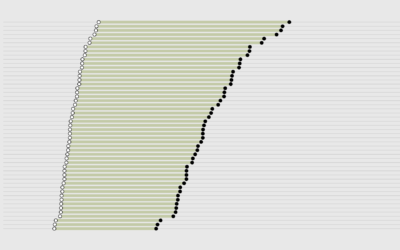Giving Up Time as a Parent
One of the challenges of parenting is that you have to spend a lot of what was once your own time caring for your kids. This time must be taken from an existing activity. After all, there is a fixed number of minutes during the day. Where do parents usually draw from?
In the same spirit of looking at time use for working adults over all of adulthood, I counted the hours for people with one child under 18 in the house and compared the totals against those without a child in the house. For simplicity’s sake, I focused on employed people from age 25 to 43 (25 is the average age Americans have their first kid), and the comparison below shows differences for the same time span.
Between the age 18 to 43, a parent with one child spends 9,572 more hours caretaking than someone without a child in the house and 1,468 more hours on household work. These hours are pulled mostly from socializing, relaxing, and work.
Again, this focuses on a subset of parents: employed and with one child.
Some parents stop working. If this is the case, the work section on the left grows by a lot more. Caring for household members and household work on the right probably increase.
Some have more than one kid. I have two, so I’m guessing more time is taken from socializing and work, and I bet a chunk of times comes from the early years of childhood. Plus, more kids means more years with a child under 18 in the house.
Anecdotally, the increase to caretaking is not linear with the increase in child count. There’s a cap and a curve that levels off somewhere. Again, I’m guessing, but I believe kids do not actually change the passing of time. They just change our perception, sometimes stretching minutes into hours or vice versa depending on the activity.
I expected the difference in sleep to be wider. 890 more hours of sleep is a lot, but relative to how much we actually sleep, it’s not all that much. This makes sense though as kids eventually sleep through the night.
 How the Average Working Adult Spends Days
How the Average Working Adult Spends Days
Zoom out to see time spent during all of adulthood.
 How to Make Square Pie Charts in R
How to Make Square Pie Charts in R
I used a modified version of this tutorial to make the graphic above.
Notes
These calculations are based on five years of responses to the American Time Use Survey between 2011 and 2015. I downloaded the data from IPUMS Time Use, which provides an extract builder that makes it much easier to grab non-aggregated data.
The ATUS isn’t a longitudinal survey that follows respondents over a number of years, so to tally these aggregates for time between age 25 to 43, I calculated the weighted mean for each age year and then summed over time. So think of these numbers as rough estimates, and remember that these are averages. We look at them to compare across activities and know that each individual person’s time varies across distributions.
Become a member. Support an independent site. Get extra visualization goodness.
See What You Get





